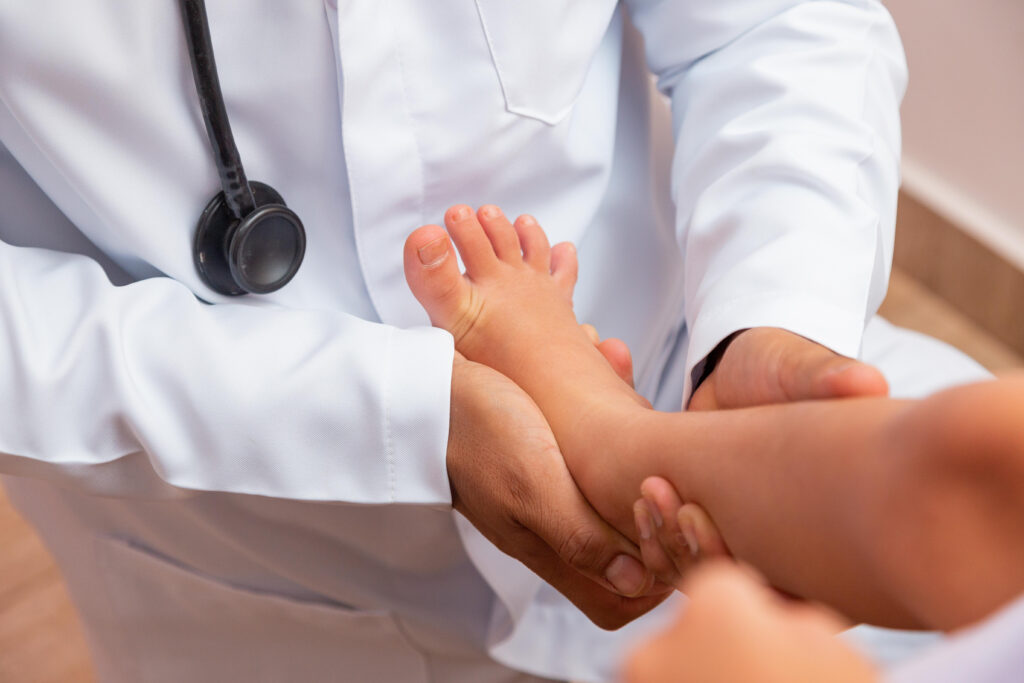What is a neuroma?
A neuroma can develop in different parts of the body when the tissue around nerves thickens or has disorganized growth (in the form of a ball-sized mass). A neuroma occurs because of nerve injury from a cut or surgery, a crush, or excessive stretching.
Neuromas can be quite painful and depending on their location, can limit a person’s motion or function if the pain is severe enough. On the other end of the discomfort spectrum, some people complain of a tingling sensation when they tap or apply pressure to the spot.
Morton’s neuroma
Morton’s neuroma is specific to the foot and affects the ball of the foot. It usually develops between the third and fourth toes, but we have seen Morton’s neuroma between the first and second toes as well.
You may also hear Morton’s neuroma referred to as Morton’s metatarsalgia, intermetatarsal neuropathy, or perineural fibroma. They all mean the same thing—the swelling and growth of tissue that surrounds the affected nerves between the metatarsal bones. This thickened nerve tissue is from the nerve being compressed and irritated consistently (which happens when someone frequently wears shoes with a narrow toe box and high heels), from a physical or sports injury, or in some cases, for no known reason.
People with certain musculoskeletal conditions such as bunions, hammertoes, or flat feet may also develop Morton’s neuroma. In children, Morton’s neuroma is often associated with running (especially sprinting) and ballet—activities that put more pressure on the ball of the foot (although ill-fitting, too-tight shoes can be a culprit, as well). Children who were born with foot deformities or certain muscular disorders may also be prone to developing a neuroma in the foot.
Morton’s toe – it’s not the same!
You might have heard of Morton’s toe, which is not related at all to Morton’s neuroma—they just happen to be named after two different physicians who shared the same last name. Morton’s toe is a common hereditary condition in which the second toe is longer than the first because the first metatarsal bone (which connects the big toe to the main part of your foot) is too short.
Symptoms of Morton’s Neuroma
Morton’s neuroma symptoms are consistent across patients. Your child may complain of:
- Tingling, burning, or numbness in the affected area
- A sharp pain between the toes (which may be relieved by removing shoes or massaging the foot)
- The feeling of having a lump inside the ball of the foot or inside the shoe
The physician will diagnose your child’s Morton’s neuroma with a physical exam that includes manipulating the foot to try and reproduce the symptoms. An X-ray or other imaging study may be performed. An accurate diagnosis is important because if not treated properly, Morton’s neuroma can lead to permanent nerve damage.
Treating Morton’s Neuroma
As with all pediatric orthopedic issues, the course of treatment for Morton’s neuroma depends on the severity of the problem. At TPOC, we always take a conservative nonsurgical approach to Morton’s neuroma treatment first.
Nonsurgical treatments
- For children involved in sports that put repetitive pressure on the neuroma, we recommend they take a break until the condition improves on its own.
- Proper stretching and warmups before playing sports are important preventative measures.
- Change shoes to those with a wider toe box (and no high heels).
- Put padding under the ball of the foot to reduce pressure on the affected nerve and help decrease the compression when your child walks.
- We can fabricate a custom orthotic to wear in the shoes for proper support and to reduce nerve compression.
- Apply an ice pack at home to the affected area to help reduce swelling.
- We may prescribe anti-inflammatory pain medication, as well.
- Morton’s neuroma exercises can be effective in managing an early-stage condition—and is important for student-athletes in general. These exercises strengthen muscles, increase muscle and ligament flexibility, improve circulation, and can reduce pain. Your pediatric orthopedist will provide a list of the various Morton’s neuroma exercises your child can do at home to stretch, strengthen, and improve balance.
If your child’s discomfort is not relieved after following these Morton’s neuroma treatments, we can administer injections of cortisone or local anesthetics for long-term pain relief.
Morton’s Neuroma surgery
In certain cases, nonsurgical treatments do not help. Our pediatric orthopedist surgeons can perform Morton’s neuroma surgery; this is a minimally invasive procedure to remove the part of the damaged nerve causing the pain or create a space around it to take the pressure off the nerve. The surgeon will make a tiny incision between the toes at the top of the foot to remove the affected nerve and might have to release tight ligaments surrounding the area. Expected recovery time is usually between two and four weeks. Your child will wear a cast or boot to protect the foot and ankle, and we’ll prescribe rest and physical therapy.
Contact The Pediatric Orthopedic Center
If your child is experiencing the sudden pain, burning or tingling associated with Morton’s neuroma, or that feeling of a bump in the shoe, call TPOC at (973) 538-7700 for a consultation, so we can make a diagnosis and recommend an appropriate treatment plan.



